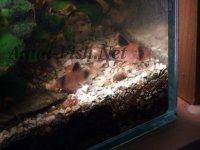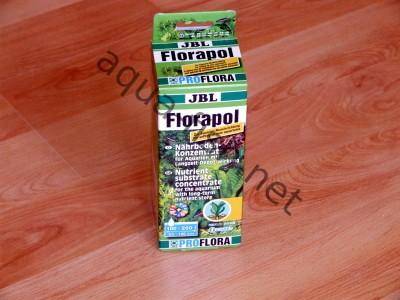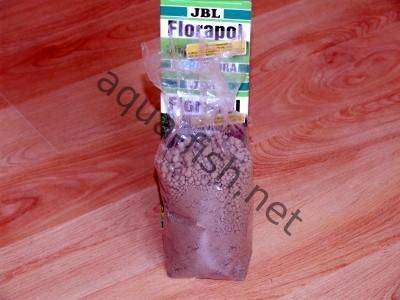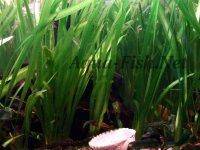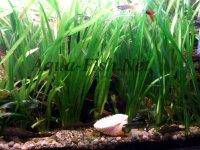Growing Vallisneria Spiralis and Anubias Nana in your aquarium and requirements of these aquarium plants
Pictures of Anubias nana
Quick links - Answers
Brief Description
People who want to grow aquarium plants are usually excited when they see nicely planted tanks with numerous plants species inside. My personal experiences say that less is sometimes more and that a man may achieve interesting layout with very few species. Currently I am focusing on growing Vallisneria Spiralis, Vallisneria Gigantea and Anubias Nana.
Introduction
My initial goal was to have two types of tanks; Planted one and rocky one. Nevertheless both of my aquariums look different now. If you're a beginner, you'll end up in a similar way just like me. Dealers will sell you ten or twenty different plants, you'll put them into the tank and as time goes by, 50% or even more will die, or will not reproduce at all. This fast is caused by different geographical origins and various habitats. Every thing's nice and green in the shop. After a couple of weeks in your fish tanks, plants become brown or overgrown with algae.
Water and light conditions
It's great if you can specify all necessities before buying. Hard and alkaline water is not suitable for plants which can be found in acidic environments and vice-versa. Litmus-paper is cheaper than buying expensive plants, and moreover it will tell you when some thing's going wrong. The location where I live is characterised by harder and alkaline waters. No wonder that I wasn't able to grow Blyxa Japonica or Cabomba Furcata (!). Chemical values depend on nitrates and bacteria living in the gravel. Also, nitrates affect algae growth (the more nitrates, the more algae). Basically, it is all interconnected.
Bear in mind that chemical values aren't the only thing which you must keep under control. Level of light is very important for every plant. Many species may grow in bright waters, some species accept all levels, and some plants require subdued light otherwise they'll die.
Why choose Vallisneria Spiralis/Gigantea and Anubias Nana
Lighting is not the most important thing, however it's influence can be figured as about 50% of success. With approximately 0.6-0.7 Watt per 1 Litre your plants will feel very happy. All three species will accept neutral or hard water where water hardness (dGH) varies somewhere between 10 and 20.
Do not buy these plants unless you're sure that water is not very acidic. Especially Vallisneria species will simply decompose in such conditions. I am writing it thanks to my personal experience.
Let's get back to this paragraph's title. Vallisneria and Anubias are able to create heavily planted sceneries which are suitable for breeding. Moreover, they are capable to grow fast (this is relative for Anubias Nana) which means your tank can be overgrown in about 2-3 months after introducing the first specimen. This is the main reason why you should consider growing these plants. Vallisneria is recommended for fish which lay eggs on plants. The fry can hide easily and weaker fish can hide from aggressive specimens. Anubias Nana is welcomed by Catfish species because the fry is practically invisible to fish living living at other level than bottom. You can see the pictures below in order to understand my ideas.
Growing, fertilization and aeration
I started with 5 Vallisneria Spiralis and 3 Vallisneria Gigantea. As time went by, the Gigantea species took over the aquarium, but was defeated by Spiralis later. Growing Anubias is a little tricky because it is quite expensive plant. I have seen shops selling 3cm of Nana for about 6-7 USD. Fortunately, some people sell it cheaply, about 3-4 USD for 10-15cm plant.
All in all, I wasn't able to grow them as I wished to. After some time I decided to help them with JBL fertilizer and adding 1 neon bulb. Despite my expectations the result was incedible. My larger aquarium is overgrown with Vallisneria Spiralis. If you take a close look it is possible to find Gigantea as well. Of course, too much light was bad for Anubias which was moved to smaller tank. The move repled a lot and I now have about 50cm of Anubias Nana.
Bear in mind that fertilizer is required for intial stages only. Once the plant adapts to conditions you won't need to use more fertilizer in my opinion. CO2 system might help, however I achieved the current state without CO2 bombs.
Good aeration should be secured. There is nothing more to say since your aerator or filter should work well anyway. Aeration helps the plants to be immune against algae.
Pictures
Anubias with algae - use good filtration to avoid such a situation
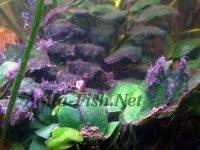
Panda Cories like to to spend a lot of time inside Anubias
